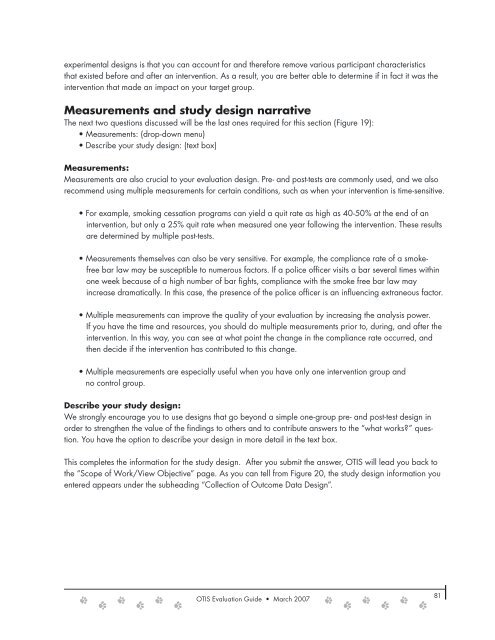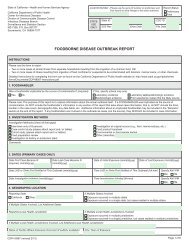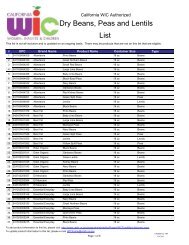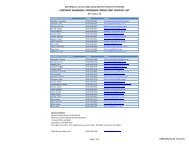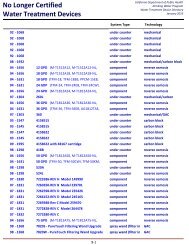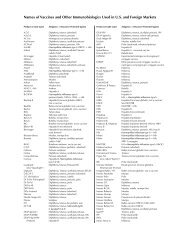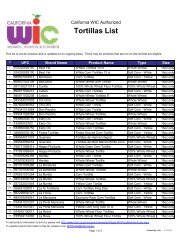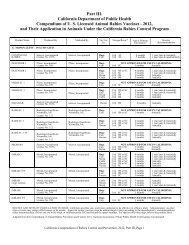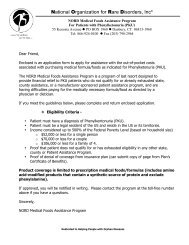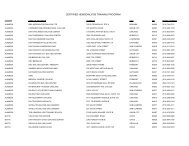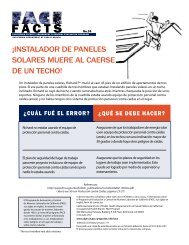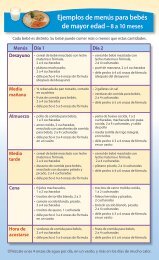OTIS Evaluation Guide (PDF) - California Department of Public Health
OTIS Evaluation Guide (PDF) - California Department of Public Health
OTIS Evaluation Guide (PDF) - California Department of Public Health
Create successful ePaper yourself
Turn your PDF publications into a flip-book with our unique Google optimized e-Paper software.
experimental designs is that you can account for and therefore remove various participant characteristics<br />
that existed before and after an intervention. As a result, you are better able to determine if in fact it was the<br />
intervention that made an impact on your target group.<br />
Measurements and study design narrative<br />
The next two questions discussed will be the last ones required for this section (Figure 19):<br />
• Measurements: (drop-down menu)<br />
• Describe your study design: (text box)<br />
Measurements:<br />
Measurements are also crucial to your evaluation design. Pre- and post-tests are commonly used, and we also<br />
recommend using multiple measurements for certain conditions, such as when your intervention is time-sensitive.<br />
• For example, smoking cessation programs can yield a quit rate as high as 40-50% at the end <strong>of</strong> an<br />
intervention, but only a 25% quit rate when measured one year following the intervention. These results<br />
are determined by multiple post-tests.<br />
• Measurements themselves can also be very sensitive. For example, the compliance rate <strong>of</strong> a smokefree<br />
bar law may be susceptible to numerous factors. If a police <strong>of</strong>ficer visits a bar several times within<br />
one week because <strong>of</strong> a high number <strong>of</strong> bar fights, compliance with the smoke free bar law may<br />
increase dramatically. In this case, the presence <strong>of</strong> the police <strong>of</strong>ficer is an influencing extraneous factor.<br />
• Multiple measurements can improve the quality <strong>of</strong> your evaluation by increasing the analysis power.<br />
If you have the time and resources, you should do multiple measurements prior to, during, and after the<br />
intervention. In this way, you can see at what point the change in the compliance rate occurred, and<br />
then decide if the intervention has contributed to this change.<br />
• Multiple measurements are especially useful when you have only one intervention group and<br />
no control group.<br />
Describe your study design:<br />
We strongly encourage you to use designs that go beyond a simple one-group pre- and post-test design in<br />
order to strengthen the value <strong>of</strong> the findings to others and to contribute answers to the “what works?” question.<br />
You have the option to describe your design in more detail in the text box.<br />
This completes the information for the study design. After you submit the answer, <strong>OTIS</strong> will lead you back to<br />
the “Scope <strong>of</strong> Work/View Objective” page. As you can tell from Figure 20, the study design information you<br />
entered appears under the subheading “Collection <strong>of</strong> Outcome Data Design”.<br />
<strong>OTIS</strong> <strong>Evaluation</strong> <strong>Guide</strong> • March 2007<br />
81


